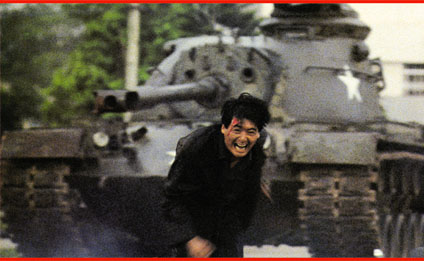 |
| a better tomorrow III: love & death in saigon |
 |
| A Better Tomorrow III: Love and Death in Saigon is an attractive film, although it is by no means an unflawed one. It has a touching, accessible love story at its centre, and features Chow Yun-Fat and Anita Mui, both of whom bring their customary weight and power to the screen and more than do justice to their respective roles. Chronologically, this film takes us back in time, to a point in time before Mark Gor became a gangster. The plot forms around a (slightly clichéd) love-triangle, and is set against the chaotic backdrop of the Vietnam War in full flight. Echoing the unease of the war is the smaller, more personal turmoil of the underworld, as experienced by Mark (Chow Yun-Fat) and Mun (Tony Leung Ka-Fai), two very close friends who travel unwittingly into Vietnam and the heart of conflict, from both the war and the underworld. In Vietnam, Mark and Mun stay with Mun’s father, who treats Mark as his adoptive son, and become involved with a charismatic woman from the underworld – a stereotypical ‘lady-with-a-very-big-gun-and-lots-of-attitude’ character who is played to perfection by the sultry Anita Mui. Both Mark and Mun fall in love with her, despite that fact that she gradually drags them deeper and deeper into the dangerous world she inhabits – a world that is completely contradictory to the safe, secure one that the two strangely innocent men inhabit. And so, they must cast of their innocence piece by piece, and begin to open their eyes to the catastrophic things happening all around them, both in the war and in the underworld. Somewhere along the way, the gangster lady teaches Mark to be a really great gangster, and even buys him his first trench-coat. How cute. Unfortunately, both those scenes feel as though they were only put into the movie to ensure it makes sense as a prequel to A Better Tomorrow, and not because they enhanced it as a movie in any way. The characters are interesting, but flawed. Mark Gor is the best, and Chow Yun-Fat gives him a lot of magnetism and charisma, although it is still hard to believe that a character who started the movie as a naïve innocent could ever become the straight-shooting, matchstick-chewing, trench coat-swishing gangster we see at the end of the film, or in A Better Tomorrow. Anita Mui’s character is also charismatic, and it’s easy to believe that she could be as tough as any man, and possess twice as many guns. However, the idea that she is the ‘female Mark Gor’ is overplayed slightly, and should have been handled with more subtlety; as it is, she comes across as slightly clichéd and stereotypical. The only character who doesn’t add anything at all to the film is Mun, played by Tony Leung Ka-Fai. Leung Ka-Fai seems grossly miscast here, and plays nothing but a nerd with glasses; he doesn’t lend his character any depth, and gives him an off-puttingly pathetic and absurd quality, which seems far more suited comedy. As a director, Tsui Hark gives Love and Death in Saigon a very different flavour to the one John Woo gave to A Better Tomorrow. Where A Better Tomorrow is dark, tragic and heavy with emotion, Love and Death in Saigon has a light and sunny atmosphere, with a lot of romance interspersed with some comedy. This in itself would make a cracking film – but then comes the action. On its own, the film would be a great Tsui Hark romantic comedy, but Hark must constantly remind the audience that they are watching a prequel to A Better Tomorrow, and so the film becomes (in places, at least) an imitation John Woo action flick. This doesn’t suit the light and sunny atmosphere, and there never seems to be enough reason for the action to appear at all. Hark directs most of the action scenes moderately well (albeit in John Woo’s trademark style), but they seem to belong in a different movie. Some of the action scenes, however, are not directed even moderately well-directed. For instance, there is one extremely silly scene in which Mark Gor, god of gangsters, armed with two huge machine guns, finds himself literally unable to shoot one bad guy at about ten paces. They are in an enclosed space, but the little bugger just keeps on ducking behind handy bits of furniture, so Mark Gor (god of gangsters) must chase him around the room for several minutes, getting increasingly cross, while Anita Mui sits helplessly on the floor. Seemingly she has miraculously lost the awesome shooting skills she possessed in the first half of the film. It’s really quite nasty. So the moral is – if you’re not John Woo, don’t try for John Woo-style action scenes. Tsui Hark is more than capable of shooting a decent gunfight himself, in his own style; he has no real need to shoe-horn himself into Woo’s style. So it would seem that most of the elements which don’t work in this film are elements that are there because Tsui Hark is trying to make a prequel to A Better Tomorrow, in John Woo’s style, and not just a film of his own. He is a wonderful director when he makes his own films, in his own style, and it is interesting to think what might have happened if Love and Death in Saigon had been made as a stand-alone film, well away from the mantle of the other two A Better Tomorrow films. But still, even as it is, the film is well worth a watch. It’s nowhere near as nasty as the truly horrid A Better Tomorrow II, and has many refreshing and unusual elements unique to Tsui Hark. And if it had not been shoe-horned to fit the other A Better Tomorrow films – it might even have been a truly great film, who knows? |